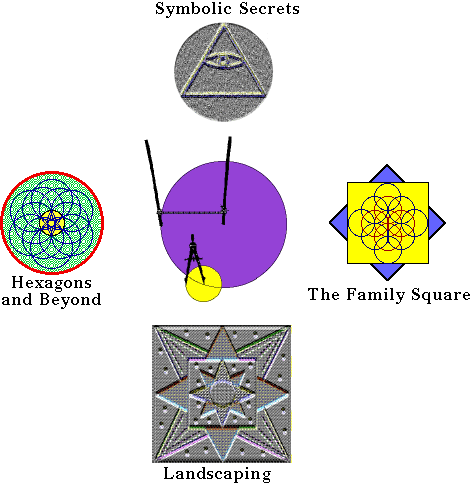DESIGNS


By way of analogy, there are exercises in English whereby students are asked to look up the roots of common words in dictionaries to find out where they come from and what they originally meant. Volumes such as the Oxford Educational Dictionary are fascinating because they include histories of a word's usage along with its root meaning. Well, the same kind of approach is taken here, except that we are looking at spatial "words," so to speak. Many symbols break down to specific families of polygons, such as the Triangle-Hexagon-Dodecagon family, the Square-Octagon family and the Pentagon-Decagon family (to be added). The task here is to explore the design variations that a particular polygon family can generate (Hexagon and Square subsections). Symbolic Secrets was developed to show how familiar symbols and logos were generated from the primary polygons.
The other dimension of this section focuses on precision because this is the heart of all mathematical exercises that examine measure. Geometric constructions are exquisite shapes that contain many concepts and lessons that can be introduced on the spot. However, to take advantage of protractor lessons and those related to proportions, some degree of precision must be reached. Like learning to write, the motor habits of young students must be conditioned and become almost second-nature. This takes time. The same is true with learning how to wield a compass. From field tests, this time can take anywhere from a day to a couple weeks among Elementary students. For example, the time required to reach protractor precision is probably a couple of days; for assessing proportional constants, maybe two weeks. If dealing with Middle or High School students, possibly a day or two.
Design exercises were found to be extremely helpful in this regard because the focus was art, and the young minds were constantly amazed at what the hand-eye exercises were doing. At the same time, the motor habits became steadier and more confident while the visual cortex became more accustomed to the built-in divisions and proportions of the shapes. Creativity steps in when it explores all the different things that can be tried.
And remember, everything that is shown in this section is scientifically grounded by the rules; everything can be described mathematically. But do not tell the children this at the beginning because you may spoil their fun.
The Design section is broken up into four parts, with others to be added down the road. No mathematics is required for any section, though it is suggested for any landscaping projects you have in mind.
Contact
E-mail: Chris Hardaker
Copyright 1994-2000, Chris Hardaker